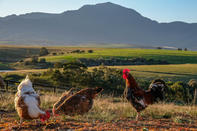While chicken may help to keep certain tick species in check on other livestock, such as cattle and around the house, they are susceptible to tampan or fowl ticks.

These bloodsucking parasites are often overlooked during poultry inspections, as the larvae could be little bigger than mites and only feed at night when birds are roosting. Poultry ticks may cause huge problems when left untreated, especially when birds are produced in large numbers in confined spaces.
What do They Look Like?
Fowl ticks are flat, oval shaped and soft, unlike the hard ticks that usually affect dogs and cats. Like mites, they have eight legs, except during the first larval stages when they have six. They may vary in size from 3 mm to 15 mm in length, depending on the species and whether they have recently fed on blood.
They may sit on vegetation in an attempt to “catch” a host, but primarily live in sheltered environments, such as crevices and nests. The larvae can survive for two months and longer, the nymphs for a year and the adults for up to three years without a blood meal.
Signs of Infestation?
They not only cause anaemia in birds, but may also transmit a number of potentially fatal diseases, such as tick paralysis, caused by toxins in their saliva, Borrelia anserine, Borrelia spirochetes, Borreliosis, Spirochaetosis, Pastuerella and West Nile virus.
Signs associated with tick infestations include paralysis, weakness, loss of weight, reduced growth, ruffled plumage, skin blemishes, poor appetite and even diarrhoea. Birds usually become restless, agitated and uneasy at night. Free-range birds might be reluctant to go into the coop.
When inspecting the birds, look out for red tiny spots where the birds might have been bitten. Ticks are usually found around the head and neck, the vent and thinly feathered parts of the body and also on the limbs.
Remember though, that they do not live on the birds and only feed at night, so inspection should be done at a good light at night. In the coop, there might be red spots near crevices and cracks that might indicate their presence.
By Glenneis Kriel